#طابع
Explore tagged Tumblr posts
Text
تريد ASL Aspire إضفاء طابع الألعاب على تعليم العلوم والتكنولوجيا والهندسة والرياضيات (STEM) للأطفال الصم
اشراق العالم 24 متابعات تقنية: نقدم لكم في اشراق العالم 24 خبر بعنوان “تريد ASL Aspire إضفاء طابع الألعاب على تعليم العلوم والتكنولوجيا والهندسة والرياضيات (STEM) للأطفال الصم ” نترككم مع محتوى الخبر لقد ابتليت مهارات القراءة والكتابة الضعيفة بمجتمع الصم وضعاف السمع لعقود من الزمن. وقد تراجعت معدلات معرفة القراءة والكتابة المتوسطة لخريجي المدارس الثانوية الصم عند مستوى الصف الرابع منذ مطلع القرن…
#ASL#Aspire#STEM#إضفاء#الألعاب#الصم#العلوم#تريد#تعليم#طابع#على#للأطفال#والتكنولوجيا#والرياضيات#والهندسة
0 notes
Text

Iraqi stamp featuring celebrated sculptor Jawad Selim
طابع بريدي من العراق يحتفي بالنحات الموهوب جواد سليم
3 notes
·
View notes
Text

[ID: Two plates of cookies, one oval and topped with powdered sugar, and the others shaped in rings; one cookie is broken in half to show a date filling; two glasses of coffee on a silver tray are in the background. End ID]
معمول فلسطيني / Ma’moul falastini (Palestinian semolina cookies)
Ma’moul (also transliterated “ma’amoul,” “maamoul” and “mamoul”) are sweet pastries made with semolina flour and stuffed with a date, walnut, or pistachio filling. The cookies are made tender and crumbly with the addition of fat in the form of olive oil, butter, or clarified butter (سمن, “samn”); delicate aromatics are added by some combination of fennel, aniseed, mahlab (محلب: ground cherry pits), mastic gum (مستكه, “mistīka”), and cinnamon.
“مَعْمُول” means “made,” “done,” “worked by hand,” or “excellently made” (it is the passive participle of the verb “عَمِلَ” “‘amila,” "to do, make, perform"). Presumably this is because each cookie is individually filled, sealed, and shaped by hand. Though patterned molds known as طوابع (“ṭawābi’,” “stamps”; singular طابع, “ṭābi’”) are sometimes used, the decorations on the surface of the cookies may also be applied by hand with the aid of a pair of small, specialized tongs (ملقط, “milqaṭ”).
Because of their laborious nature, ma’moul are usually made for feast days: they are served and shared for Eid, Easter, and Purim, a welcome reward after the Ramadan or Lenten fasts. For this reason, ma’moul are sometimes called “كَعْك العيد” (“ka’k al-’īd,” “holiday cakes”). Plates of the cookies, whether homemade or store-bought, are passed out and traded between neighbors in a practice that is part community-maintenance, part continuity of tradition, and part friendly competition. This indispensable symbol of celebration will be prepared by the women of a family even if a holiday falls around the time of a death, disaster, or war: Palestinian food writer Laila El-Haddad explains that "For years, we endured our situation by immersing ourselves in cooking, in our routines and the things we could control."
Other names for these cakes exist as well. Date ma’moul–the most common variety in Palestine–may be called كَعْك بعَجْوَة (“ka'k b'ajwa”), “cakes with date paste.” And one particular Palestinian variety of ma’moul, studded with sesame and nigella seeds and formed into a ring, are known as كَعْك أَسَاوِر (“ka'k 'asāwir”), “bracelet cakes.” The thinner dough leads to a cookie that is crisp and brown on the outside, but gives way to a soft, chewy, sweet filling.
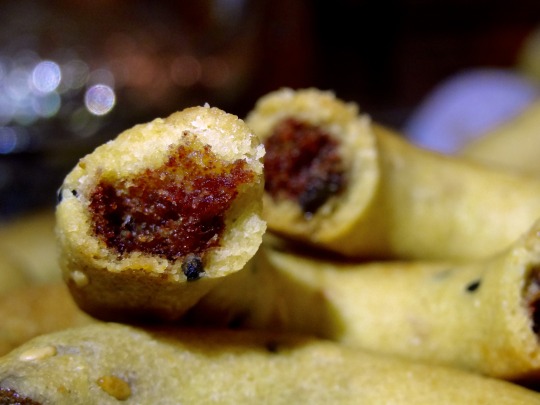
[ID: An extreme close-up on one ka'k al-aswar, broken open to show the date filling; ma'moul and a silver teapot are very out-of-focus in the background. End ID]
History
Various sources claim that ma’moul originated in Egypt, with their ancestor, كحك (kaḥk), appearing in illustrations on Pharaonic-era tombs and temples. The more specific of these claims usually refer to “temples in ancient Thebes and Memphis,” or more particularly to the vizier Rekhmire’s tomb in Thebes, as evidencing the creation of a pastry that is related to modern kahk. One writer attests that this tomb depicts “the servants mix[ing] pure honey with butter on the fire,” then “adding the flour by mixing until obtaining a dough easy to transform into forms” before the shaped cookies were “stuffed with raisins or dried dates and honey.” Another does not mention Rekhmire, but asserts that “18th-dynasty tombs” show “how honey is mixed with butter on fire, after which flour is added, turning the substance into an easily-molded dough. These pieces are then put on slate sheets and put in the oven; others are fried in oil and butter.”
Most of these details seem to be unfounded. Hilary Wilson, summarizing the state of current research on Rekhmire’s tomb, writes that the depicted pastries were delivered as an offering to the Treasury of the Temple of Amun; that they certainly contained ground tiger nuts; that they presumably contained wheat or durum flour, since ground tiger nuts alone would not produce the moldable dough illustrated; that the liquid added to this mixture to form the dough cannot be determined, since the inscription is damaged; that the cakes produced “are clearly triangular and, when cooked are flat enough to be stacked” (any appearance that they are pyramidal or conical being a quirk of ancient Egyptian drawing); that they were shallow-fried, not cooked in an oven; and that honey and dates are depicted at the far left of the scene, but their relationship to the pastries is unclear. There is no evidence of the honey being included in the dough, or the cookies being stuffed with dates; instead, Wilson speculates that “It appears that the cooks are preparing a syrup or puree of dates and honey. It is tempting to think that the cakes or pastries were served [...] with a generous portion of syrup poured over them.” Whether there is any direct lineage between these flat, fried pastries and the stuffed, molded, and baked kahk must also be a matter of speculation. [1]
Another origin claim points to ancient Mesopotamia. James David Audlin speculates that ma’moul are "possibly" the cousins of hamantaschen, both being descended from the molded "kamānu cakes that bore the image of [YHWH’s] goddess wife Inanna [also known as Ishtar or Astarte]" that were made in modern-day Syria. Other claims for Mesopotamia cite qullupu as the inspiration: these cakes are described in the contemporary record as wheat pastries filled with dates or raisins and baked. (Food historian Nawal Nasrallah writes that these cookies, which were offered to Ishtar for the new year festival in spring, may also be an origin point for modern Iraqi كليچة, "kleicha.")
The word "määmoul" had entered the English language as a type of Syrian farina cake by 1896.
In Palestine
From its earliest instantiations, Zionist settlement in Palestine was focused on building farming infrastructure from which Palestinians could be excluded: settlers, incentivized by foreign capital, aimed at creating a separate economy based around farms, agricultural schools, communal settlements, and research institutions that did not employ Arabs (though Arab labor and goods were never entirely cut out in practice).
Zionist agricultural institutes in Palestine had targeted the date as a desirable crop to be self-sufficient in, and a potentially profitable fruit for export, by the 1930s. Ben-Zion Israeli (בנציון ישראלי), Zionist settler and founder of the Kinneret training farm, spoke at a 1939 meeting of the Organization of Fruit Growers (ארגון מגדלי פירות) in the Nahalel (נהלל) agricultural settlement to discuss the future of date palms in the “land of Israel.” He discussed the different climate requirements of Egyptian, Iraqi, and Tunisian cultivars—and which among them seemed “destined” (נועדים) for the Jordan Valley and coastal plains—and laid out his plan to collect saplings from surrounding countries for planting despite their prohibitions against such exports.
In the typical mode of Zionist agriculture discourse, this speech dealt in concepts of cultivation as a means of coming into a predestined ownership over the land; eating food suited for the climate as a means of belonging in the land; and a return to Biblical history as a triumphant reclamation of the land from its supposed neglect and/or over-cultivation by Palestinian Arabs over the past 2,000 years. Israeli opened:
נסתכל לעברה של הארץ, אשר אנו רוצים להחיותה ולחדשה. היא השתבחה ב"שבעה מינים" ואלה עשוה אינטנסיבית וצפופת אוכלוסין. לא רק חיטה ושעורה, כי אם גם עצים הנותנים יבול גדול בעל ערך מזוני רב. בין העצים -- הזית [...] הגפן, התאנה והתמר. לשלושה מהם, לזית, לתאנה ולתמר חטאה התישבותנו שאין היא נאחזת בהם אחיזה ציםכר של ממש ואינה מפתחת אותם דים.
We will look to the past of the land [of Israel], which we want to revive and renew. It excelled in "seven species," and these flourished and became densely populated. Not only wheat and barley, but also trees that give a large and nutritious crop. Among the trees: the olive, [...] the vine, the fig and the date. For three of them, the olive, the fig and the date, it is the sin of our settlement that it does not hold on to them with a strong grip and does not develop them.
He continued to discuss the benefits of adopting the date—not then part of the diet of Jewish settlers—to “health and economy” (בריאות וכלכלה). Not only should the “land of Israel” become self-sufficient (no longer importing dates from Egypt and Iraq), but dates should be grown for export to Europe.
A beginning had already been made in the importation of about 8,000 date palm saplings over the past two decades, of which ¾ (according to Israeli) had been brought by Kibbutz Kinneret, and the remaining ¼ by the settlement department of the Zionist Commission for Palestine (ועד הצירים), by the Mandate government's agriculture department, and by people from Degania Bet kibbutz ('דגניה ב). The majority of these imports did not survive. More recently, 1000 smuggled saplings had been planted in Rachel’s Park (גן רחל), in a nearby government plot, and in various places in the Jordan Valley. Farms and agricultural institutions would need to collaborate in finding farmers to plant dates more widely in the Beit-Sha’an Valley (בקעת בית שאן), and work to make dates take their proper place in the settlements’ economies.
These initial cuttings and their descendents survive in large plantations across “Israel” and the occupied Palestinian territories. Taher Herzallah and Tarek Khaill write that “Palm groves were planted from the Red Sea in the south along the Dead Sea, and as far as the Sea of Galilee up north, which has given the Israeli date industry its nickname ‘the industry of the three seas’” Since Israel occupied the Palestinian West Bank in 1967, it has also established date plantations in its illegal settlements in that portion of the Jordan Valley.” Today, these settlements produce between 40 and 60% of all Israeli dates.
In 2022, Israel exported 67,042 tons of dates worth $330.1 million USD; these numbers have been on a steady rise from 4,909 tons worth $1.2m. in 1993. Palestinian farmers and their children, disappropriated from their land and desperate for income, are brought in to date plantations to work for long hours in hazardous conditions for low pay. Workers are lifted into the date palms by cranes where they work, with no means of descending, until the crane comes to lower them down again at the end of the day. Injuries from falls, pesticides, heat stroke, and date-sorting machinery are common.
Meanwhile, settlers work to curtail and control Palestinian production of dates. The Palestinian population in the West Bank and Gaza is used as a pool of cheap labor and a captive market to purchase Israeli imports, absorb excesses in Israeli goods, stabilize Israeli wages, and make up for market deficits. Thus Palestinian date farmers may be targeted with repressive measures such as water contamination and diversion, destruction of wells, crop destruction, land theft, military orders forbidding the planting of trees, settler attacks, closing of checkpoints and forbidding of exports, and the denial of necessary equipment or the means to make it, in part to ensure that their goods do not compete with those of Israeli farmers in domestic or foreign markets. Leah Temper writes that these repressive measures are part of a pattern whereby Israel tries to “stop [Palestinian] growth in high value crops such as strawberries, avocados and dates, which are considered to be ‘Israeli Specialties’.”
At other times, Palestinian farmers may be ordered to grow certain crops (such as strawberries and dates), and forbidden to grow anything else, when Israeli officials fear falling short of market demand for a certain good. These crops will be exported by Israeli firms, ensuring that the majority of profits do not accrue to Palestinians, and that Palestinians will not have the ability to negotiate or fulfill export contracts themselves. Nevertheless, Palestinian farmers continue to defy these oppressive conditions and produce dates for local consumption and for export. Zuhair al-Manasreh founded date company Nakheel Palestine in 2011, which continues production despite being surrounded by Israeli settlements.
Boycotts of Israeli dates have arisen in response to the conditions imposed on Palestinian farmers and workers. Herzallah and Khaill cite USDA data on the effectiveness of boycott, pressure, and flyering campaigns initiated by groups including American Muslims for Palestine:
Israel’s exports of dates to the US have dropped significantly since 2015. Whereas 10.7 million kilogrammes (23.6 million pounds) of Israeli dates entered the US market in 2015-2016, only 3.1 million kilogrammes (seven million pounds) entered the US market in 2017-2018. The boycott is working and it is having a detrimental effect on the Israeli date industry.
Date products may not be BDS-compliant even if they are not labeled as a product of Israel. Stores may repackage dates under their own label, and exporters may avoid declaring their dates to be a product of Israel, or even falsely label them as a product of Palestine, to avoid boycotts. Purchase California dates, or dates from a known Palestinian exporter such as Zaytoun or Yaffa (not “Jaffa”) dates.
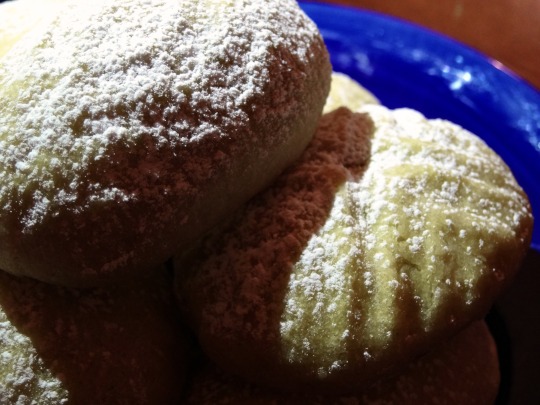
[ID: Close-up of the top of ma'moul, decorated with geometric patterns and covered in powdered sugar, in strong light and shadow. End ID]
Elsewhere
Other efforts to foreground the provenance and political-economic context of dates in a culinary setting have been made by Iraqi Jew Michael Rakowitz, whose store sold ma’moul and date syrup and informed patrons about individual people behind the hazardous transport of date imports from Iraq. Rakowitz says that his project “utilizes food as a point of entry and creates a different platform by which people can enter into conversation.”
[1] Plates from the tomb can be seen in N. de G. Davies, The tomb of Rekh-mi-Rē at Thebes, Vol. II, plates XLVII ff.
Purchase Palestinian dates
Donate to evacuate families from Gaza
Flyer campaign for eSims
Ingredients:
Makes 16 large ma'moul and 32 ka'k al-aswar; or 32 ma'moul; or 64 ka'k al-aswar.
For the dough:
360g (2 1/4 cup) fine semolina flour (سميد ناعم / طحين فرخة)
140g (1 cup + 2 Tbsp) white flour (طحين ابيض)
200g (14 Tbsp) margarine or vegetarian ghee (سمن), or olive oil
2 Tbsp (15g) powdered sugar
1 1/2 Tbsp (10g) dugga ka'k (دقة كعك)
1/2 tsp (2g) instant yeast
About 2/3 cup (190mL) water, divided (use milk if you prefer)
1 tsp toasted sesame seeds (سمسم)
1 tsp toasted nigella seeds (قزحه / حبة البركة)
Using olive oil and water for the fat and liquid in the dough is more of a rural approach to this recipe; ghee and milk (or milk powder) make for a richer cookie.
To make the bracelets easy to shape, I call for the inclusion of 1 part white flour for every 2 parts semolina (by volume). If you are only making molded cookies and like the texture of semolina flour, you can use all semolina flour; or vary the ratio as you like. Semolina flour will require more added liquid than white flour does.
For the filling:
500g pitted Madjoul dates (تمر المجهول), preferably Palestinian; or date paste
2 Tbsp oil or softened margarine
3/4 tsp dugga ka'k (دقة كعك)
3/4 tsp ground cinnamon
5 green cardamom pods, toasted, skins removed and ground; or 1/4 tsp ground cardamom
Small chunk nutmeg, toasted and ground, or 1/4 tsp ground nutmeg
10 whole cloves, toasted and ground, or 1/4 tsp ground cloves
The filling may be spiced any way you wish. Some recipes call for solely dugga ka'k (or fennel and aniseed, its main components); some for a mixture of cinnamon, cardamom, nutmeg, and/or cloves; and some for both. This recipe gives an even balance between the pungency of fennel and aniseed and the sweet spiciness of cinnamon and cloves.
Palestinian date brands include Ziyad, Zaytoun, Hasan, and Jawadir. Palestinian dates can also be purchased from Equal Exchange. You can find them online or at a local halal market. Note that an origin listed as "West Bank" does not indicate that a date company is not Israeli, as it may be based in a settlement. Avoid King Solomon, Jordan River, Mehadrin, MTex, Edom, Carmel Agrexco, Arava, and anything marked “exported by Hadiklaim”. Also avoid supermarket brands, as the origin of the dates may not be clearly marked or may be falsified to avoid boycots.

Instructions:
For the dough:
1. Melt margarine in a microwave or saucepan. Measure flours into a large mixing bowl and pour in margarine; mix thoroughly to combine. Rub flours between your hands for a few minutes to coat the grains in margarine. The texture should resemble that of coarse sad. Refrigerate the mixture overnight, or for up to 3 days.
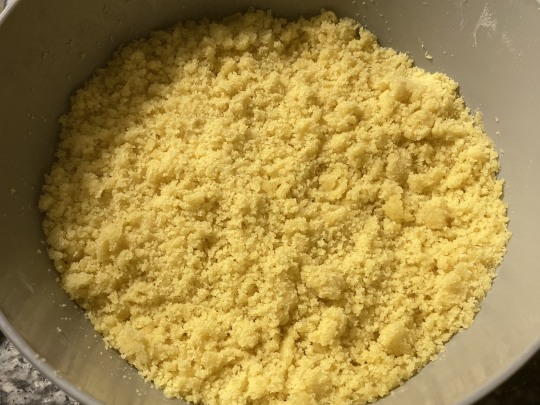
2. Add dry ingredients to dough. If making both molded ma'moul and ka'k al-aswar, split the dough in half and add sesame and nigella seeds to one bowl.
3. Add water to each dough until you get a smooth dough that does not crack apart when formed into a ball and pressed. Press until combined and smooth, but do not over-knead—we don't want a bready texture. Set aside to rest while you make the filling.
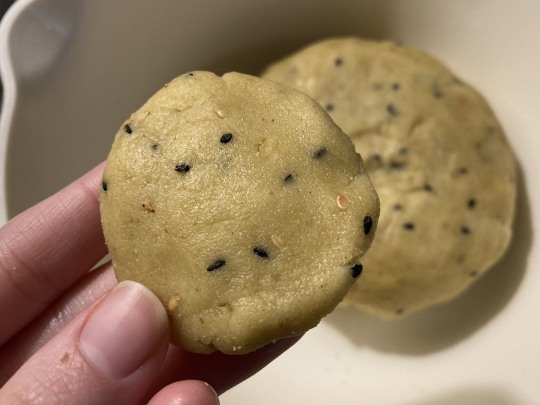
For the filling:
1. Pit dates and check the interiors for mold. Grind all ingredients to a paste in a food processor. You may need to add a teaspoon of water, depending on the consistency of your dates.
To shape the cookies:
Divide the filling in half. One half will be used for the ma'moul, and the other half for the bracelets.
For the ma'moul:
1. With wet hands, pinch off date filling into small chunks about the size of a walnut (13-16g each, depending on the size of your mold)—or roll filling into a long log and divide into 16-20 even pieces with a dough scraper. Roll each piece of filling into a ball between your palms.
2. Divide the dough (the half without seeds) into the same number of balls as you have balls of filling, either using a kitchen scale or rolling into a log and cutting.
3. Form the dough into a cup shape. Place a ball of filling in the center, and fold the edges over to seal. Press the dough into a floured ma'moul mold to shape, then firmly tap the tip of the mold on your work surface to release; or, use a pair of spiked tweezers or a fork to add decorative designs by hand.

4. Repeat until all the the dough and filling has been used, covering the dough you're not working with to keep it from drying out. Place each cookie on a prepared baking sheet.
For the ka'k al-aswar:
1. With wet hands, divide the date filling into about 32 pieces (of about 8g each); they should each roll into a small log about the size of your pinkie finger.
2. Divide the dough (the half with the seeds) into as many pieces as you have date logs.
3. Take a ball of dough and flatten it into a thin rectangle a tiny bit longer than your date log, and about 3 times as wide. Place the date log in the center, then pull the top and bottom edges over the log and press to seal. Seal the ends.

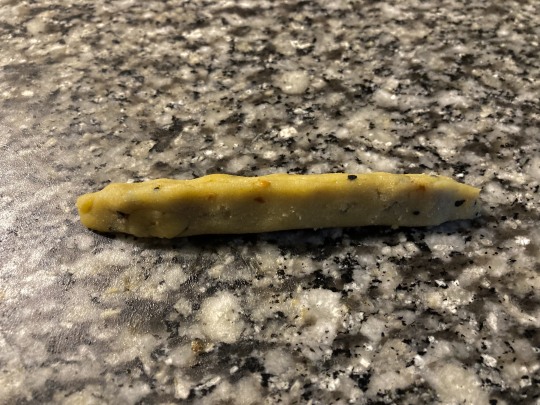
4. Roll the dough log out again to produce a thin, long rope a little bit thinner at the very ends than at the center. Press one side of the rope over the other to form a circle and press to seal.
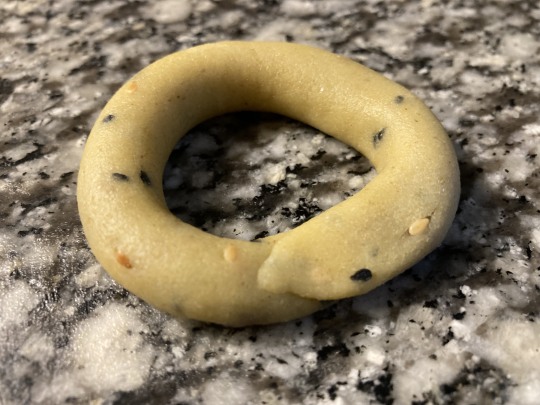
5. Repeat until all the the dough and filling has been used, covering the dough you're not working with to keep it from drying out. Place each cookie on a prepared baking sheet.
To bake:
1. Bake ma'moul at 350 °F (175 °C) in the center of the oven for about 20 minutes, until very lightly golden brown. They will continue to firm up as they cool.
2. Increase oven heat to 400 °F (205 °C) and bake ka'k al-aswar in the top third of the oven for about 20 minutes, until golden brown.
Sprinkle cookies with powdered sugar, if desired. Store in an airtight container and serve with tea or coffee, or give to friends and neighbors.
394 notes
·
View notes
Text
الاحترام هو أجمل هديه يقدمها الإنسان للناس....فالأدب لا يباع ولا يشترى....بل هو طابع في قلب من تربى....كن لأخيك سنداً ولأختك معينا ... و لصديقك محسناً ولجارك وفيا...دنيا فانيه وكلنا راحلون....فأترك بين الناس أثراً طيباً.
اللهم احسن خاتمتنا وأسعدالله صباحكم
83 notes
·
View notes
Text
بين كل متاحبين أو متعاشرين ينشأ " قاموس لغـــــوي خاص" لا يفهمه سواهما ... لغةً جديدةً ... الكلمات فيها ذات طابع مختلف ، طابع غير معجمي من حيث نوعية الكلمات المستخدمة في الترحيب، اختيار اسم المنادىٰ، صيغة السؤال والجواب ...... فروق طفيفة ذات دلالات شاسعة لا يعيها إلا من نشأت بينهما هذه اللغة.
44 notes
·
View notes
Text

من بين كل الكتب التي وقعت تحت يدي عن الحب والعلاقات، كان هذا هو الكتاب الذي شعرت أنه يلامسني، الكتاب الذي يعبر عما أعرفه وفي نفس الوقت يخبرني ما لم أكن أعرفه. الكتاب الذي أخذني من يدي ليريني الصورة الكاملة، لأعلم أني كنت أحدق في قطعة واحدة من البازل.
لطالما كرهت الحيل والألعاب التي نضطر إلى لعبها مع الناس في علاقاتنا العاطفية معهم، كنت أتوق إلى كتاب هو عصارة خبرة وتجربة طبيب نفسي عن الحب، وإذ به يقع تحت يدي، وإذ به يهمس لي بما كنت أعلمه في قرارة نفسي. الحب ليس معركة شرسة لإثبات الذات، وليس محاولة لإبهار الآخر، وليس ذريعة لأن تشعر بالخزي والعار بسبب كل ما هو جزء أصيل منك، مادمت تكف أذاك عن حبيبك. الحب ليس "شبحنة" إصدار الأحكام القاسية على الآخرين في لحظة الرفض. الحب يعلمنا رؤية ما وراء السطح الذي نعبده. الحب، بحق، يختبيء في ثنايا علاقاتنا الحقيقية مع أناس تشبهنا، وتنسجم معنا، وتلبي احتياجاتنا بدلاً من الضغط على مواطن النقص فينا، ونكأ جراحنا وصدماتنا القديمة.
ولهذا قررت ترجمة مقدمة الكتاب، آملاً ترجمة بقية فصول الكتاب تباعًا.
_____
علاقات أعمق (كيف تتخل عن ألعاب الإغواء، وتكتشف معنى الحميمية) (لماذا لا تحتاج لأن تبدو في أبهى صورة، أو تتصرف بثقة أو بتمنُّع لتعثر على الحب الحقيقي)
د. كين بيدج
مقدمة: الخريطة الجديدة للحب
حين أقع في الحب، إما سيدوم للأبد أو لن أقع في الحب أبدًا.
— مقطع من أغنية "حين أقع في الحب"
لطالما أحببت أغنية "حين أقع في الحب". ليقينها الطفولي طابع جذاب وحكيم. ولكنها لا تنطبق على قصة حبي بالتأكيد. وربما لا تنطبق على قصتك. بالنسبة لأغلبنا، فالبحث عن الحب لم يكن سهلاً أبدًا. ولا عجب، فلقد منحونا خريطة للحب ترشدنا بعيدًا عن الحميمية الحقيقية. وماذا أقصد بذلك؟ انظر إلى أغلفة معظم المجلات التي تدعي أنها تساعدك في العلاقات. ما الذي يخبرونك أن تفعله؟ افقد الوزن، ارتد ملابس أفضل، تمنَّع وكن بعيد المنال، تصرف بثقة، اخرج وتعرَّف على المزيد من الناس، بمعنى آخر، أصلح من نفسك ليكون لديك ذرة أمل للعثور على الحب.
وهذه ليست تنمية ذاتية. هذا عقاب ذاتي متخفي. وعقاب الذات لا يؤدي إلى علاقة عاطفية سليمة. بدلاً من مساعدتنا على تقبل ذواتنا الحقيقية، فإن عالم العُزَّاب يعلمنا أن نُجمِّل أنفسنا في أعين الآخرين. وحينما نأخذ هدنة تكفي أخيرًا لأن نتوقف عن لوم أنفسنا على عيوبنا، ندرك أن هذه الطريقة لا تُفضي إلى شيء.
فكر فيها: كل هؤلاء الشباب الرائعين الفاتنين الظرفاء الذين تعرفهم، هل هم أكثر عرضة لأن يكونوا في علاقات صحية وآمنة ومفعمة بالحب؟ أشك في ذلك كثيرًا. لأن هذه ليست الصفات التي تؤدي إلى حب يدوم. هي صفات قد تؤدي إلى مواعدات أكثر، أو على الأرجح تمنحك فرصًا أعلى لممارسة الجنس، ولكن أن تحظى بحب دائم؟ لا أعتقد ذلك بتاتًا.
طريق العلاقة المفعمة بالحب مُعبَّد بأشياء أكثر عمقًا وأهمية بكثير، أشياء تغير حياتنا، أشياء لم نتعلمها قط. البحث الحقيقي عن الحب يتضمن تقبل النسخة الأكثر حقيقية وأصالة من أنفسنا، ومشاركة أنفسنا الحقيقية مع من يحترموها من المقربين منا والعزيزين علينا، وفي المقابل نتعلم نحن أيضًا احترام النسخة الحقيقية من أنفسهم. المفارقة المذهلة في الأمر، هي أن هناك سمات معينة في شخصيتنا، نعتقد أننا لن ننعم بالحب إلا بعد إصلاحها، برغم كونها مفاتيح العثور على هذا الحب.
ستمشي طريقًا لا تهتدي فيه بإصلاح نفسك، ولكن باحترام معدنها الحقيقي، والتعبير عن قدراتك ومواهبك الفطرية. وهذا يغير كل شيء. بدلاً من جلد نفسك بسوط التنمية الذاتية، كما اعتا�� الكثير منا قضاء وقتًا طويلاً وهو يفعل ذلك، ستتعلم أن تثق وتُقدِّر وتعبر عما أسميه مواهبك الأساسية.
وما هي المواهب الأساسية؟ أنها ببساطة ما يثير حساسيتك العميقة في الحياة. وستعثر عليها في أكثر ما يُلهمِك، وأكثر ما يلمسك بعمق، وأكثر ما يؤلمك. نميل عادةً إلى إخفاء الأجزاء الهشة منا، ونلجأ إما إلى إصلاحها أو إخفاءها، ظنًا منا أن هذا ما يجعلنا أكثر جاذبية، ولكن العكس التام هو الصحيح. هشاشتنا هي أسرع وسيلة نحصل بها على الحميمية الحقيقية. وحينما نتعلم الاتكاء على مواهبنا الأساسية، تنقلب حياتنا رأسًا على عقب. تصير جاذبيتنا الشخصية أكثر بهاءًا. والأهم، فأننا نقترب من الحب الذي استعصى علينا من قبل، حبًا يعطينا القدرة لنكون أنفسنا ويمنحنا السعادة.
أتمنى لو أن شخصًا ما استطاع شرح كل هذا لي خلال السنوات التي كنت أبحث فيها عن الحب. ضاعت مني سنوات عديدة لم أبحث فيها عن الحب إلا عبر تغيير نفسي إلى نسخة أكثر قابلية للتسويق. ولا يمكنني أن أحصي عدد الساعات التي قضيتها وأنا أبحث عن الحب في الأماكن التي افتقرت للحب، وبوسائل كانت أبعد ما يكون عن الحب. كن لطيفًا. كن ظريفًا. وإذا شعرت باحتياج "غير لائق" في لحظة معينة، اكبته، وابتلعه.
أثناء هذه العقود التي أطلق عليها اسم "العزوبية المزمنة"، كان خوفي الأكبر هو أني سأخوض الحياة بدون أن أعثر أبدًا على الحب الحقيقي. وعلى مدار عشرينياتي، لم تستغرق أطول علاقاتي مدة تتعدى الشهور. قضيت الكثير جدًا من الليالي أبحث عن الحب، وانتهى بي المطاف جالسًا في مطعم، ألتهم شطيرة "تشيز برجر" محترمة لأواسي نفسي. تحسنت حياتي العاطفية حين بدأت في التماس المساعدة من أصدقاء حكماء ومعالجين نفسيين متمرسين. وبرغم ذلك، راوغتني العلاقات الصحية المفعمة بالحب. وصرت شبه متأكدًا أني لا أصلح بطبيعتي للعلاقات. وفي هذا الوقت كنت قد صرت معالجًا نفسيًا خبيرًا ومرموقًا، ومع ذلك، كنت أؤمن في قرارة نفسي ببعض أكبر الخرافات الثقافية المتعلقة بكيفية الظفر بالحب، وكانت محاولاتي تبوء بالفشل دومًا.
ولم يقتصر الأمر عليّ، ففي خضم معاناتي للعثور على الحب، عملتُ مع عددًا لا يُحصى من العُزَّاب كمعالج نفسي، عُزَّاب كانوا يعانون من نفس خيبات الأمل ومواطن عدم الأمان.
"أشعر وكأني حذاء رياضي قابع في الغسالة. أقابل شخصًا جديدًا فيفعمني الأمل، لأُنال نفس "العلقة" السابقة "لا قلم زاد ولا قلم نقص"!
"بعد تجارب طلاقي الثلاث، في أواخر ستينياتي، أعتقد أن فرصتي في أن أنال حبًا حقيقيًا ضعيفة للغاية. وكل ما أشعر به أنني "بضاع�� معيوبة".
تشير أمي إلى نباتاتها المنزلية وتخبر أصدقائها: "هؤلاء هم أحفادي." أنا محامي ناجح يعيش حياة رائعة، ولكني في عين أمي، وبالنسبة لنفسي، أشعر بأني مجرد شخص فاشل لأنني أعزب.
كما هو حال العديد من مرضاي، شعرتُ وكأن هناك خللاً فادحًا في تركيبتي الأساسية. لماذا ظللت أنجذب لأناس ليسوا مناسبين لي؟ ولماذا حين أقابل أناس لطفاء مراعين تتملكني الرغبة في الهرب منهم؟ لماذا من رغبت فيهم إلى أقصى حد لم يبادلوني الشعور قط، في حين أن هؤلاء من سعوا إلى خطب ودي لم يثيروا اهتمامي على الإطلاق؟ عند نقطة ما في هذه الرحلة، صارت هذه الدائرة المفرغة اللانهائية من الأمل وخيبة الأمل واضحة كالشمس. أدركت أني أمضيت أعوامًا طويلة أبحث عن الحب، ولكني لم أبذل جهدًا قط لبناءه وتمهيد الطريق له.
بدأت أبحث عن إجابات أعمق، على أمل كشف سبب التكرار المربك لنمط علاقاتي الفاشلة، التي هي حياتي العاطفية، أنا والعديدين غيري. طلبت مساعدة معالجين نفسيين، وأصدقاء ومدربين. وتعلمت الكثير جدًا. على مدار عدة سنوات من الدراسة والنضج والصراع، بدأت أدرك أن هناك طريقًا لا يؤدي فقط إلى الحب الصحي، بل يؤدي أيضًا إلى شفاءنا الشخصي. أنه طريق مواهبنا. تبيّن أن سماتي الشخصية التي حاولت جاهدًا أن أخفيها لأحظى بالحب، كانت هي نفسها طريقي إلى شريكي، وإلى حياة تزخر بالألفة والحميمية.
ولقد تعلمت العديد من الدروس عن الحب، بقدر الدروس التي علمتها. في عام 2005، بعدما ألقيت العديد من المحاضرات ونظمت العديد من الندوات المتعلقة بالحميمية والبحث عن الحب، أنشأت ورشة تُدعى "علاقات أعمق"، يمكن للعُزَّاب فيها أن يقابلوا بعضهم البعض في أجواء تشجع على اللطف واستكشاف الذات والمرح والضحك والنقاش. آلاف العُزَّاب من جميع الأعمار والخلفيات والميول الجنسية حضروا هذه الورش، وأخبرني العديد منهم كم كانوا سعداء بحضور فعالية للعُزَّاب جعلتهم يشعرون بالرضا عن أنفسهم بدلاً من الشعور بأنهم يخذلون أنفسهم. هذه المحاضرات التي ألقيتها في هذه الفعاليات منحتني فرصة الكتابة في مواقع "سايكولوجي توداي" و"هافنغتون بوست"، والردود الرائعة التي تلقيتها عن هذه المقالات دفعتني لكتابة هذا الكتاب.
والآن حين أقوم بتدريس دروس عن العلاقات الأعمق، يكون رد الفعل دومًا ابتسامات التقدير ودموع الراحة. لقد شهدتُ الحياة العاطفية للناس وهي تتغير بشكل كبير، يكاد يكون ��عجازي، حينما يمارسون هذه المهارات المتعلقة بالحميمية الحقيقية في خضم سعيهم للحب.
التوق للحب حكمة وليس ضعفًا
من بين جميع الخرافات المؤذية التي تُلقَّن لنا، فإن أحد أسوأها هي تصديق أن التوق للحب ضعف. وأنا لا أتفق مع ذلك. التوق للحب ليس ضعفًا. بل حكمة. وكبت إحساسنا بالوحدة يؤدي لليأس الذي يُمرِض ثقافتنا بأسرها. نحن ليس من المقدر لنا أن نكون وحيدين ومكتفين ذاتيًا. وبدون أن يملأ علينا الحب حياتنا، نذبل ونموت من داخلنا. الحميمية هي الأكسجين الذي نتنفسه. ونحن لا نحتاج لأن نسمو فوق جوعنا للحب، بل نحتاج إلى أن ننال كفايتنا منه.
وفقًا للطبيب النفسي إيلي فينكل، وهو من أكثر الباحثين احترامًا في مجال العلاقات والانجذاب بين الناس، فإن مدى حميمية العلاقة هي أحد أعظم العوامل التي تحدد صحتك الجسدية والنفسية. وهذا يؤكد ما شعرتَ به طوال الوقت: العثور على الحب شيء بالغ الأهمية. مجرد إمساك يد شخص تحبه يُخفِض ضغط الدم ويقلل الألم. ما الذي يمكن أن يعبر ببلاغة عن حاجتنا إلى التواصل أكبر من هذه القصيدة الشعرية المتشحة بالعلم؟
لقد وجدت أن الأشخاص الذين يشعرون أنهم بحاجة إلى الحميمية هم أكثر من يعثرون عليها. إذا كنت تتوق إلى حب يكون حنونًا وشغوفًا في نفس الوقت، فهنئ نفسك على شجاعتك وتصميمك على البحث عنه. وأنا أدعوك لأن ترى هذا التوق الكامن بداخلك كأحد تجليات حكمتك وشجاعتك، وليس كعلامة على ضعفك.
لقد رأيتُ أناسًا شُخِّصوا بأمراض مميتة وعثروا على الحب لأول مرة في حياتهم، لأن حقيقة موتهم الوشيك دفعتهم لإدراك أهمية الحب في حياتهم. لقد رأيتُ من هم في التسعينيات من عمرهم، وقد بلغ بهم الوهن والمرض مبلغه، ولكن غمرتهم إثارة الوقوع في الحب، بعدما اختاروا الإقبال على الحميمة بكل كيانهم.
وشعرت بذلك بنفسي في حياتي الخاصة. كانت رغبتي المستمرة في الحب حافزاً للعديد من التغييرات الإيجابية. لقد أجبرتني على الاعتراف بأنني كنت أدفع نفسي بعيدًا عن الحب وأنا أتخيل أني أقترب منه، وأن عليّ تغيير تلك الأنماط بمساعدة مرشدين محبين. هذه التغييرات الصعبة هي التي مكنتني من خلق الحياة العاطفية المفعمة بالحب التي أنعم بها اليوم، وساعدتني على إنشاء هذه الخريطة الجديدة للحب التي ساعدت العديد من الناس في العثور على الحميمية التي يتوقون إليها.
ليست وعودًا كاذبة
في كتاب "ديبر ديتنج" (أو علاقات أعمق) لن تجد نصيحة واحدة بشأن تحسين مظهرك، أو المغازلة بشكل أفضل، أو التصرف بثقة أكبر، أو دفع شريكك لئلا يعرفك عن ظهر قلب لتحتفظ بفضوله فيك. (ولن تساعدك نصيحتي في هذه الأشياء على أي حال، ��لقد فشلت فشلاً ذريعًا في تطبيق هذه الحيل!) كما أنني لن أعدك بأنك ستنال الحب في ثلاثة أشهر، أو في أي فترة زمنية أخرى. فهذا ليس وعدًا يمكن الوفاء به، وبشكل شخصي، أنا لا أثق في أي شخص يدعي أنه بإمكانه الوفاء بهذا الوعد. ثمة غموض يكتنف كيفية وموعد العثور على الحب، وهو غموض خارج عن سيطرتنا.
سيظل العالم يخبرك أنك تحتاج لممارسة الحيل لتعثر على الحب، ونعم، هذه الحيل تؤتي بثمارها إذا كان هدفك هو الجنس، أو إقامة علاقة جديدة ذات أساس هش. ولكنها على الأرجح لن تساعدك على إيجاد الحب الحقيقي.
بقدر ما يتم دفعنا لتصديق أن الحصول على الحب يتعلق بتحسين أنفسنا، فإن إنسانيتنا هي ما تتيح لنا إيجاد الحب الحقيقي ورعايته. ولكن لا تصدقني أنا. جرب الأفكار التي سأوردها في هذا الكتاب، وسترى أن التغييرات التي ستحل بحياتك هي ما تثبت فعالية مواهبك الخاصة.
هذا الكتاب مخصص لأي شخص أعزب، وأي شخص يرغب في فهم أعمق للمنابع الحقيقية للحميمية. أنه كتاب مخصص للرجال والنساء من جميع الأعمار والخلفيات والميول الجنسية والهويات الجندرية. مهما كان عمرك، أو دخلك، فهناك أناسًا رائعين في الدنيا ينتظرون أن يعثروا على شخص مثلك.
نخوض الرحلة الحقيقة للعثور على الحب على مستويين: الداخلي والخارجي. وكلاهما ضروري، ولكن ثقافتنا تتجاهل الجهد الذي يتوجب علينا بذله للتعامل مع دواخلنا. يمكنك اعتبار هذا الكتاب خريطة للمستويين: كتاب إرشادي لأهم رحلة في حياتك، رحلتك نحو الحميمية. هذا الكتاب الذي يتضمن بداخله دورة دراسية لديه القدرة على توجيهك نحو الحب الحقيقي، ونحو منبعه بداخلك. أعتقد أنك ستحب ما يحدث، لأنك حينما تشارك مواهبك الأعمق بشجاعة وسخاء وتميز، ما تحصل عليه في المقابل هو الحب.
84 notes
·
View notes
Text

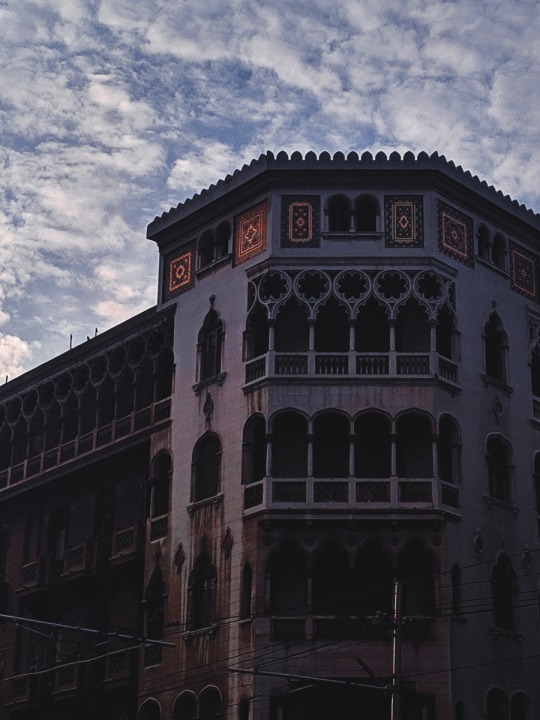


الإرث المعماري في الإسكندرية له طابع خاص.
126 notes
·
View notes
Text
انا مغرمة بالعمارة الإسلامية لها طابع مميز ومبهر ووقعها على العين مريح بشكل لا يوصف وألوانها جميلة أوي أوي
74 notes
·
View notes
Text
#قطر مدينة حالمة جداً يعجبني فيها كونها تمسكت بتراثها وأصالتها في كل مكان تلاقي طابع شرقي، يدل على حضارتها هذا اللي يميزها عن أي من دول الخليج واولها دبي، لكن ينقصها روح البشر، مرتبة بزيادة بالنسبة لي احس اني محاصرة لازم اكون كلاس طول الوقت، احب العشوائية ماحب كل شي مصفضف، حتى شعبها محترم بزيادة، الموضوع يوتر شوي
اول ما رجعت مطار السعودية ، قال لي موظف الجوازات؟ افتحي لي على رحلة قطر فتحت له البحرين قال واضح انك دجتي لين قلتي امين وقعد يضحك حنا السعوديين مختلفين جداً، اكاد أجزم اننا أفضل شعب، كرم، خفة دم، مرونة، شهامة ، احبك يا بلدي 💚









19 notes
·
View notes
Text
ظاهرة العبور من الباب
في كتابها الجميل الذي أوقن أنه سيصبح من كتبي المفضلة في العالم، تحكي سڤيتلانا أليكسيفتش عن ضابطة المقاومة الروسية التي عملت متخفية كنادلة مطعم يتردد عليه الجنود الألمان في الحرب الثانية. كانت مكلفة بتسميم هؤلاء الجنود، لكنها وجدت هذا عملًا رهيبًا، رغم أن الجنود الألمان أحرقوا القرى وأهلكوا الحرث والنسل، رغم أنهم أبادوا أهلها شخصيًا، ذلك أن الواحد منهم كان يقول لها بعد أن تضع له طبق الحساء: "كم هو لذيذ، شكرًا". والكتاب حافل بقصص تصلح كل واحدة منهن أن تكتسب طابع الأسطورة، غير أن هذه القصة نالت مني منالًا عظيمًا.
في هذه الأيام الجارية، لاحظت ما أسميته "ظاهرة العبور من الباب"، وفيه أشير -في حديثي لنفسي- لذلك التحول الرهيب في نظرتي لمريض/ة في اللحظة التي يعبر فيها باب العيادة ويجلس أمامي ويتكلم. أقضي سحابة نهاراتي كالطبيب البشري الوحيد في عيادة طب الأسرة في وحدة تخدم منطقة مزدحمة، مطلوب مني أن أكشف على عدد مهول من الأشخاص يوميًا وأن لا أفقد عقلي وأحافظ على معتقداتي الطبية. ويتسبب ذلك في مشاحنات يومية، وتذمر لا ينتهي أسمعه من داخل العيادة، وحنق مني على المريض العنيد، ونظرات غاضبة أرمي بها المنتظرين في حلق الباب وأنا أترقب الفرهدة القادمة.
يتغير ذلك الشعور تمامًا -وأدعي أنه يتغير على الجانبين- ما إن أشترك مع واحدهم في حديث واستماع. لا أنس تلك السيدة التي ظلت تقتحم العيادة هي وطفلها مرة بعد مرة وأنا أتشاجر معها وأرى الغضب يتجمع في عينيها من طول الانتظار ومن سوء الأحوال. لما حان دورها شاهدت عينيها تتسعان لما لقيته من اهتمام، تحول غضبي على عدم احترامها للدور إلى تعاطف وشفقة عظيمين نحو هذه الشابة التي تمتلك تاريخًا مرضيًا حافلًا بأشياء أقساها تشخيصها بورم خبيث في سن الثلاثين، عشر دقائق من الاستماع وضعت هذه السيدة أمام ناظري في تقاطعات رهيبة من الظلم الچندري حيث يضربها زوجها، والاقتصادي حيث أنها لم تحظ بتعليم ولا تستطيع إعالة أطفالها، والتفسيري: حيث أنها لا تدرك أن طفلها الصعب الذي لا تستطيع فهمه يعاني من طيف من التوحد. دفعني تقديري لوضعها إلى فهم تصرفاتها السابقة، بل وأني عجبت منها كيف لا تخرج على العالم شاهرةً سيفها.
لا تنفك تلك الظاهرة عن التكرار. في المسافة البسيطة التي يتطلبها عبور الباب، في الدقائق التافهة التي يتطلبها أخذ التاريخ المرضي باهتمام؛ يعاد خلق ال��شر أمامي، وأومن أن الأمر متبادل، يخرج الواحد/ة منهم مبتسمًا مطلقًا علي النعوت اللطيفة بعد أن دعى علي بأن ينالني من الله ما أستحق من كام ثانية فقط.
أحالني ذلك لتلك اللحظات الصغيرة في كشك الخياطة، تلك اللحظات التي تفصل بين خياطة خمس حالات نزفت بغزارة وأغرقت الأرض دمًا ترك لفترة، وبين دخول عمال التنظيف لمسحه بشكل دوري، لطالما ذهلت من أن رائحة الأجساد البشرية المفتوحة والأنسجة المتهتكة تشبه بالضبط رائحة محلات الجزارة. أمر بديهي ومروع في آن. الإنسان قطعة من اللحم، ما الذي يجعله إنسانًا؟ متي تحول اللحم الحيواني الشائع إلى إنسان حرام، مقدس الوجود؟
لا بد أنها لحظة شبيهة بظاهرة العبور من الباب، وعى الإنسان أنه موجود وأدرك الأشياء والشعور والألم وأدرك وجود الآخر وميز فيه ذات الملكات وأسبغ عليه ذات الصفات التي وجدها في نفسه. هكذا نشأت الأخلاق التي فصلت الإنسان عن المملكة الحيوانية، بداية من التعاطف: من قدرة الواحد/ة على وضع نفسه مكان غيره. ومهما يكن من تفسير علمي لتلك الظاهرة الفاتنة، ومن عزوها لناقلات كيميائية في النواقل العصبية، ومن أعمال فيسلوفة الأعصاب باتريشا تشرشلاند، ومن إيمان المؤمن بأن في الإنسان جوهر إلهي لا يمكن تفسيره بالبيولوچيا، مهما يكن من أمر، فأنا أعتقد أن مراقبتك لأي إنسان بأي طريقة، بالنظر أو الاستماع أو بمعرفة قصته، ستعيد خلق هذا الإنسان أمام عينيك بما يشبه المعجزة.
لا أعرف من أن تأتي تلك الهالة الإنسانية، من البيولوجيا أو من ما وراء العالم، لكن الأكيد أنها تأتي عبر الإنسان نفسه، الصفة الإنسانية عمل جماعي، أنت تميز أني أكثر من قطعة لحم تافهة وأنا أفعل المثل فنتحول لإنسانين، إذا توقف هذا الإجماع تتضح بسهولة مرتبتنا في المملكة الحيوانية.
في كتابها الجميل تحكي أليكسيفيتش عن قناصة روسية في الحرب الثانية، تذكر أيامها الأولى في الجبهة لما ذهبت محملة بغضب ورغبة في الانتقام من الألمان، تطلب عملها مراقبة الجنود عبر عدسة بندقية القنص، ولما حانت ساعة التنفيذ طلبت من صديقتها التنفيذ بدلًا عنها، لأنها لا تقوى على إنهاء حياة إنسان "شاهدته يتحرك ويروح ويجئ" ولو لوهلة بسيطة بل وعبر منظار بندقية قنص. عبر الجندي إليها من حلق الباب. وأنا أنبهر من سهولة أنسنة الواحد لغيره، وبساطة المطلوب لدفعه لذلك، لكن الأكثر رعبًا هو سهولة نزع تلك الهالة عن أحدهم برضه، وذلك الشعور المرعب بأنك تتأرجح بين حالتين من كمال الإنسانية وعدمها بحسب تقلب الحكام وأمزجة البشر وأهواء اللاعبين الإقليميين في المنطقة، عشرات الملايين من العوامل التي بإمكانها أن تخرجك رغمًا عنك من حلق الباب أو تدخلك فيه. شئ عجيب.
66 notes
·
View notes
Note
أهلاً، لا أعلم من ذاك الذي تجرأ و قال أن كتاباتك مملة، على العكس لكتاباتك طابع خاص مميز و 🤍رومانسي، لا تهتم لكلام الناس و القيل و القال..تجاهل ما قال و انساه
أهلين،
تتباين الأذواق وتختلف الأراء يا أنون، وبالنسبة لي كل وجهات النظر - حتى وإن كانت قاسية - أتقبلها وأحترمها. أكيد الرأي في الاسك الأخير لا أعتبره ذو تأثير، وإن كنت أعتذر عن إصابتي ��أي إنسان بالملل 🙃.
وكل الشكر لك على الكلام اللطيف والراقي 🌹🌹
36 notes
·
View notes
Text
Piano Concerto No. 1 in B-flat minor | Tchaikovsky
مقطوعة الملحن الروسي تشايكوفسكي ذات طابع حماسي ودراماتيكي، يشتمل على تقنيات عزف بيانو صعبة للغاية تبرز براعة العازف. تتميز بأجواء عاطفية قوية، مزيج من الحيوية والقوة والرومانسية.
18 notes
·
View notes
Text


«هناك أمور قد تصدر من الإنسان لا ينفع معها الاعتذار ولا التراجع، لأن المسألة أصلا لا تتعلق بالعفو والمسامحة بل بشيء آخر، ثمة أخطاء لها طابع خاص أخطاء عميقة وكاشفة، والقضية معها ليست أن تسامح أو لا تسامح بل أنت أمام فهم وانطباع جديد تشكّل، أمام حقيقة ظهرت أكثر من كونها مجرد عثرة»
29 notes
·
View notes
Text

أفضل قراءات السنة، رواية شبه سيرة ذاتية عن تجربة الموت. الإعجاز في هذا العمل هو الوصف. هي رواية وصفية لتجربة الموت في ثلاثة أيام فقط! فماذا يمكن لكاتب أن يقول في وصف عائلة تمر بحادثة موت أحد أفرادها؟ والخط الزمني لها ثلاثة أيام أو أقل. تجربة روائية مختلفة، كئيبة، لكن سرها الإبداعي في قدرة آجي على التقاط كل هذا: ما يدور بداخل رؤوس الشخصيات، الايماءات والالتفاتات، ضوء الشمس المنعكس على ستائر الدانتيل، نبرة الصوت، كوب الشاي المرّ، صوت صرير الخشب، رائحة المنزل، الإيحاءات من أتفه حوار بين شخصيتين أو أكثر، ملمس العشب، شبح شخص قادم من بعيد، رائحة التبغ، عفن الأنفس البشرية وكبريائها، كل ما هو مادي ومحسوس، وروحي وذو طابع نفساني وغير مرئي، لم يتركه آجي .. وغيرها مما لا يمكن تخيل كاتب يحصي كل هذا القدر الوصفي الدقيق بشكل يتغلغل في ذهنك ويرسم صورة واضحة جداً ومحسوسة من حسن الوصف لتجربة الموت التي مر بها آجي نفسه. ولذلك من المستحيل أن تجربة هذه القراءة تمر بشكل عابر على القارئ، ولا يمكن أن يمر بدون أن يشعر بشعور آجي نفسه أو شيء منه.
12 notes
·
View notes
Text
كل مرة بتفرج فيها علي فيلم الباب المفتوح بعجب بالفيلم أكتر و أكتر كل حاجة في الفيلم ده جميلة وحنينة وليها طابع خاص و كل مرة بشوفه فيها بيراودني في ذهني تساؤل هل في راجل زي حسين بتمسكه بليلي بطرقه المتعددة في انه يقنعها انها تحبه رغم معرفته بخوفها من الحب لينجرح قلبها تاني ومحاولاته العديده انه يساعدها تدور علي ذاتها وتعرفها اكتر ويكون عايز يشوفها امرأة قوية وليها شخصية ومش بتخاف؟ بحب اسم الفيلم اوي ومتأكدة ان سبب تسميته بالاسم ده هي كل الحاجات اللي حسين ��ملها عشان ليلي وصلتها للباب المفتوح اللي هو دلالة عن حريتها وحريتها في الفيلم مكنتش حاجة فجة بالعكس كانت بس ان يكون عندها اختيار تعرف اصلا تختار بنفسها بدون تردد او ضغط من الاهل ،تعمل الحاجات اللي بتحبها كل دي حاجات ليلي مكنتش هتعرف بردة تعملها الا لو كان جواها قوة بس هي مكنتش عارفة انها موجودة وحسين هو اللي ساعدها انها تكتشفها 💛
15 notes
·
View notes
Text




الشاطبي، الإسكندرية.
بحب الشاطبي وبحب هدوئها، وإنها منطقة ليها طابع خاص وشوارعها ساكتة، وبحب بيوتها إللي الرطوبة قشرت واجهتها وخلت ليها ملامح خاصة.
30 notes
·
View notes